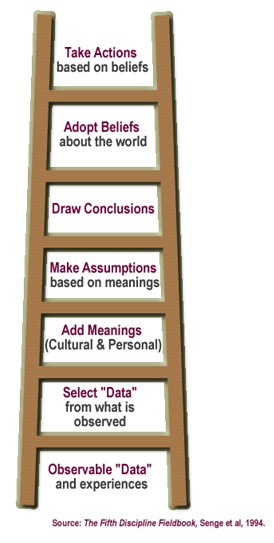If you love lots of drama in your life, stop reading this now.
Here's a phenomenon I've been talking to my clients about lately. It explains how we create a lot of drama and anguish for ourselves and others, usually without being aware of it. It's important to understand, because, if you do, you can save yourself (and others) a lot of that unnecessary pain, anguish, bad decisions and, oh, the drama.
It's called the "ladder of inference". This concept was introduced by Chris Argyris, a brilliant thinker in the field of Organizational Development. You can picture this as a ladder, and we work our way from the bottom, up.
Here's how it goes. 1. We observe something... maybe it's something someone does that we find annoying or troubling. 2. Our brain filters out and only considers part of the data from what we observed. This filter is usually a factor of our internal biases, prejudices and negative emotions. Yuck. So we... 4. "embellish" the facts with some of our own "meaning", usually cultural and personal. Can you see where this is going? NOT GOOD! Next, we 5. Make Assumptions, based on the meaning we just ascribed. And it's flawed. But we don't see that. So we...6. Draw Conclusions, based on incorrect assumptions, which themselves flowed from erroneous meaning. As a result of all of this, we 7. Adopt or Reinforce Beliefs about the world. "All men are jerks!", or "You can't get good help!"... that sort of thing. And finally, we 8. Take Action, based on our incorrect beliefs. All of this can happen in a few seconds. It all takes us from a fact to a decision or action. Usually a damaging, incorrect decision or action.
The
Ladder of Inference describes the thinking process that we go through,
usually without realizing it, to get from a fact to a decision or
action. The thinking stages can be seen as rungs on a ladder and are
shown in Figure 1. - See more at:
http://www.mindtools.com/pages/article/newTMC_91.htm#sthash.SjUl3UDM.dpuf
Understanding the Theory:
The Ladder of Inference describes the thinking process that we go through, usually without realizing it, to get from a fact to a decision or action. The thinking stages can be seen as rungs on a ladder and are shown in Figure 1.
- Experience these selectively based on our beliefs and prior experience.
- Interpret what they mean.
- Apply our existing assumptions, sometimes without considering them.
- Draw conclusions based on the interpreted facts and our assumptions.
- Develop beliefs based on these conclusions.
- Take actions that seem "right" because they are based on what we believe.
By using the Ladder of Inference, you can learn to get back to the facts and use your beliefs and experiences to positive effect, rather than allowing them to narrow your field of judgment. Following this step-by-step reasoning can lead you to better results, based on reality, so avoiding unnecessary mistakes and conflict.
- See more at: http://www.mindtools.com/pages/article/newTMC_91.htm#sthash.SjUl3UDM.dpuf
Understanding the Theory:
The Ladder of Inference describes the thinking process that we go through, usually without realizing it, to get from a fact to a decision or action. The thinking stages can be seen as rungs on a ladder and are shown in Figure 1.
- Experience these selectively based on our beliefs and prior experience.
- Interpret what they mean.
- Apply our existing assumptions, sometimes without considering them.
- Draw conclusions based on the interpreted facts and our assumptions.
- Develop beliefs based on these conclusions.
- Take actions that seem "right" because they are based on what we believe.
By using the Ladder of Inference, you can learn to get back to the facts and use your beliefs and experiences to positive effect, rather than allowing them to narrow your field of judgment. Following this step-by-step reasoning can lead you to better results, based on reality, so avoiding unnecessary mistakes and conflict.
- See more at: http://www.mindtools.com/pages/article/newTMC_91.htm#sthash.SjUl3UDM.dpuf

Ever catch yourself climbing this 'Ladder of Inference"? If you do... GREAT! That's the first step. When we become aware that we do it, we begin to have other choices.
Cheers,
-Ed
Understanding the Theory:
The Ladder of Inference describes the thinking process that we go through, usually without realizing it, to get from a fact to a decision or action. The thinking stages can be seen as rungs on a ladder and are shown in Figure 1.
- Experience these selectively based on our beliefs and prior experience.
- Interpret what they mean.
- Apply our existing assumptions, sometimes without considering them.
- Draw conclusions based on the interpreted facts and our assumptions.
- Develop beliefs based on these conclusions.
- Take actions that seem "right" because they are based on what we believe.
By using the Ladder of Inference, you can learn to get back to the facts and use your beliefs and experiences to positive effect, rather than allowing them to narrow your field of judgment. Following this step-by-step reasoning can lead you to better results, based on reality, so avoiding unnecessary mistakes and conflict.
- See more at: http://www.mindtools.com/pages/article/newTMC_91.htm#sthash.SjUl3UDM.dpuf

No comments:
Post a Comment